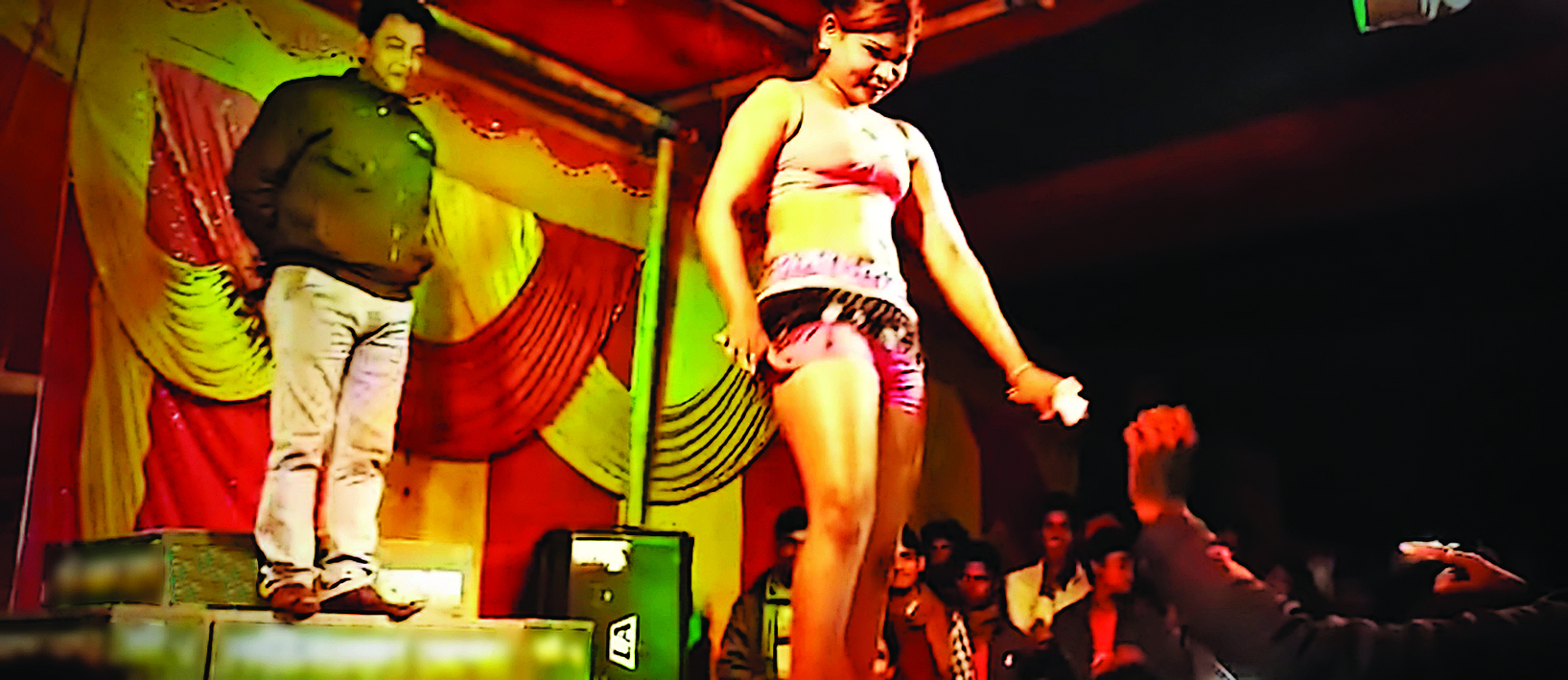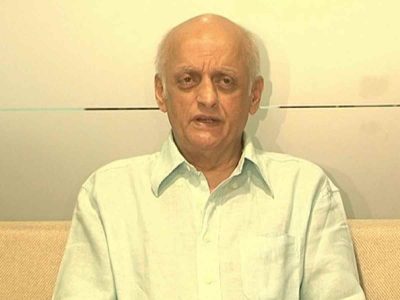A look at the democratisation of cheap thrills in the hinterland
Amid the cheering arkestra crowd, you often come across the odd sight of very serious looking men, as if they are trying to find the arithmetic mean between public decency and raunchy collectivity. Lurking in the background or trying to be invisible in the front rows, they seem struggling between embarrassment and inhibitions. They generally look stunned.
That, however, isn’t a problem for the most in the crowd who cheer, whistle and ogle as young girls and women dance to titillating Bollywood and Bhojpuri pop numbers. In a way, when “orchestra” was misspelt as “arkestra”, the typo was a sign of things to come. It was cast in its distortions, not in its musical connotations. In Bihar, eastern Uttar Pradesh, Jharkhand and West Bengal, the last two decades have witnessed arkestra asserting itself as a democratisation of cheap thrills.
It has become the most potent crowd-puller, next only to monetary allurements. Political parties haven’t missed registering that message in their crowd mobilisation strategies. That was evident again last Saturday in Patna. The Opposition circulated a video showing that on the eve of the Bharatiya Janata Party led-National Democratic Alliance’s Sankalp rally in Gandhi Maidan, an arkestra dance performance was organised to keep the crowd interested. The irony, however, lies in the fact that in August 2017, on the eve of the Rashtriya Janata Dal-led Opposition’s “BJP Bhagao” rally, a similar sleazy dance performance was organised.
It’s an all-party strategy in Bihar; the temptation to organise these shows in Gandhi Maidan seems irresistible for parties in the state.
Gandhi Maidan, known as Patna Lawns during colonial times, is a sprawling space, impressive when filled to capacity. Even the heady days of the Jayaprakash Movement of the mid-1970s—which was heralded here—couldn’t fill its entire spread. Perhaps that explains why it’s the stuff of mobilisation fantasies, with political heavyweights and parties organising events at this historic site in the state capital.
However, the footpath stalls circling Gandhi Maidan provide a clue as to why arkestra is now a convenient way to realise the “crowd targets” that party workers are assigned. The answer lies in a form of disappearance and its replacement by something which was more privileged earlier.
It’s a change that’s not very different from what the Internet did for high-value porn in India: it democratised its access across class barriers. Before that, a type of local porn printing industry, popularly known as the generic category of Mastram, did exist. It was even hinted at in works ranging from the literary—like Shrilal Shukla’s novel Raag Darbaari (1968) set in Uttar Pradesh—to the academic, like Arvind N Das’s The Republic of Bihar (1992).
Earlier, locally produced Mastram books outsold the heavily-priced glossy English magazines like Debonair, Fantasy or international brands like Playboy. The latter, with high visual content, was considered the under-mattress privilege of the elite. The Internet changed that in significant ways, not least of which was breaking the class divide.
By the turn of the century, cybercafes became the site of the democratic shift in porn consumption. Consumers of expensive porn magazines as well as Mastram-reading prurient millions found common ground as consumers of easily available sleaze online. The corner cabins of cybercafes were not for breathtaking information exchange but pulsating porn exploration and erotic talk disguised as romance. The price barrier of unequal Internet access has also been considerably neutralised by the next phase in the shift: the mobile revolution and cheap data packages.
The public services offered by free WiFi facilities had the unintended effect of flattening the porn access barriers further. A case in point is a study about free WiFi at Patna railway station. The study found that maximum searches on its free network were for porn sites. This coincides with the fact that shops selling local porn books have disappeared from the streets in the capital and the state—including those that once did business on the footpaths of Gandhi Maidan.
Though not porn in any sense, the growing popularity of arkestra in the last two decades has almost coincided with this shift in people’s sleazy entertainment. If Internet porn broke the privileged access to expensively-produced porn, arkestra is an answer to the privileged access to cabarets. The latter had been the fantasy for generations fed with Bollywood cabarets performed by sensually-clad women.
That’s where the changing face of the hinterland’s “dirty dancing” can’t be captured by shallow attempts like Anarkali of Aarah (2017). The dressing, songs and moves are far more eclectic than the stereotypes of a bawdy folk dancer. The leather pants, hot pants, spaghetti tops and costumes make it as close to the item songs ambience of Bollywood numbers as possible. The songs also range from sexually explicit regional pop numbers to raunchy Bollywood hits.
To an extent, technology has also changed the mode of ogling and objectification. Whistling is supplemented by laser lights flashed onto the bodies of the dancers, with hundreds of mobile phones jostling with each other to get close shots of the most provocative moves. While the instincts, by very definition, remain basic, it’s the means of commodifying the female body which has found new visual language in arkestra.
But sexually provocative public dance performances aren’t new to the hinterland Hindi belt. They were earlier reserved for either annual melas or for special guests and baraats in the weddings of the wealthy, influential and the local elite. In various accounts, even the most sexually suggestive of such private performances in weddings were registered with euphemisms of a form of art.
When it comes to village fairs, even Phanishwarnath Renu’s Maare Gaye Gulfaam, the story which inspired Basu Bhattacharya’s film Teesri Kasam (1966), has a travelling nautanki girl at its centre, someone who is subjected to lustful advances. That form of dancing at village fairs still persists, and its scale is quite large in events like the Sonepur Mela. In the 2018 edition of the famous cattle fair, theatre dancing was one of the major attractions and did brisk business amid the declining interest in the fair’s activities.
But even the nature of theatre dancing in village fairs has changed to compete with arkestra. The costumes, songs and other factors which build the ambience of titillation now follow the tropes of Bhojpuri pop and Bollywood item songs. More importantly, it’s now not limited to an annual gathering. Arkestra is now far more frequent, almost the fixture in largely male-attended social dos and revelries. Ranging from festival pandals and celebratory events to promotional and electoral campaigns, it has grown into the go-to event for instant gratification. It’s not restricted to Bihar or UP: even Haryana and Rajasthan have their own raunchy dancing circuit. So, do hostels in Delhi University, where special events have been excuses for organising such performances by hostel student bodies.
However, in Bihar, it has a subtext of power play too which is fuelled at two levels. First, local strongmen and dabangs see organising a grand arkestra studded with star power as a measure of their clout. They’re keen on showcasing it to the local population by roping in well-known names from Bollywood to dance at special events. This was evident in how a few years ago, Mokama MLA Anant Singh—also knowns as chote sarkar—organisedShefali Zariwala’s dance performance in his political stronghold. Besides dabangs and political leaders, the competition for star power at their own arkestra events can be seen in organisations and political parties.
Second, when organised by a particular social group, the songs played in some of the arkestra events become a means of asserting social claims on women. In the process, they amount to turning sexual harassment into a competitive demonstration of social power. This aspect has been discussed in another piece on this website.
So, this is the scene: dimly-lit villages, flies buzzing, men ogling dancers who are made up to resemble someone in a glamorous event in a metropolitan city. It might sound like the hinterland gettings its revenge on the privileged erotic amusement in urban middle-class spaces, like cabarets and dance bars. While finding mass catharsis in such events, they’ve also ensured that their videos pop up on any YouTube search of the word arkestra, as if “orchestra” has short-changed them.
www.newslaundry.com





